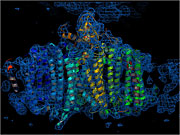Home > Press > An X-ray laser captures the structures of life
 |
| An X-ray laser captures the structures of life |
Abstract:
Two studies published recently in Nature demonstrate how the unique capabilities of the world's first hard X-ray free-electron laser—the Linac Coherent Light Source, located at DOE's SLAC National Accelerator Laboratory—could revolutionize the study of life.
An X-ray laser captures the structures of life
Menlo Park, CA | Posted on March 21st, 2011In one study, an international research team used the LCLS to demonstrate a shortcut for determining the 3-D structures of proteins.
The laser's brilliant pulses of X-ray light pulled structural data from tiny
protein nanocrystals, avoiding the need to use large protein crystals
that can be difficult or impossible to prepare. This process could lop
years off the structural analysis of some proteins and allow scientists
to decipher tens of thousands of others that are out of reach
today, including many involved in infectious disease.
In a separate paper, the same team reported making the first single-shot images of intact viruses, paving the way for snapshots and movies of molecules, viruses and live microbes in action.
Since the publication of these papers, members of the research team have returned to SLAC to continue their studies of proteins involved in photosynthesis, parasitic disease and other important life processes. Using the Coherent X-ray Imaging instrument (CXI)—the fourth instrument to become operational since the LCLS opened for research in 2009—the researchers shined highly energetic "hard" X-rays at the photosynthetic protein complex Photosystem I and an enzyme that breaks down proteins, extracted from the parasite that causes African sleeping sickness.
Though the results of these more recent studies won't be known until extensive analysis of the data has been completed, the researchers were extremely excited to see fine, crisply detailed protein structures at near atomic-scale resolution.
"It's going very well," said SLAC researcher Marvin Seibert, grinning. "The fireworks are back. It's always fun."
####
For more information, please click here
Copyright © DOE
If you have a comment, please Contact us.Issuers of news releases, not 7th Wave, Inc. or Nanotechnology Now, are solely responsible for the accuracy of the content.
| Related News Press |
News and information
![]() Simulating magnetization in a Heisenberg quantum spin chain April 5th, 2024
Simulating magnetization in a Heisenberg quantum spin chain April 5th, 2024
![]() NRL charters Navy’s quantum inertial navigation path to reduce drift April 5th, 2024
NRL charters Navy’s quantum inertial navigation path to reduce drift April 5th, 2024
![]() Discovery points path to flash-like memory for storing qubits: Rice find could hasten development of nonvolatile quantum memory April 5th, 2024
Discovery points path to flash-like memory for storing qubits: Rice find could hasten development of nonvolatile quantum memory April 5th, 2024
Imaging
![]() Nanoscale CL thermometry with lanthanide-doped heavy-metal oxide in TEM March 8th, 2024
Nanoscale CL thermometry with lanthanide-doped heavy-metal oxide in TEM March 8th, 2024
Laboratories
![]() A battery’s hopping ions remember where they’ve been: Seen in atomic detail, the seemingly smooth flow of ions through a battery’s electrolyte is surprisingly complicated February 16th, 2024
A battery’s hopping ions remember where they’ve been: Seen in atomic detail, the seemingly smooth flow of ions through a battery’s electrolyte is surprisingly complicated February 16th, 2024
![]() NRL discovers two-dimensional waveguides February 16th, 2024
NRL discovers two-dimensional waveguides February 16th, 2024
Govt.-Legislation/Regulation/Funding/Policy
![]() NRL charters Navy’s quantum inertial navigation path to reduce drift April 5th, 2024
NRL charters Navy’s quantum inertial navigation path to reduce drift April 5th, 2024
![]() Discovery points path to flash-like memory for storing qubits: Rice find could hasten development of nonvolatile quantum memory April 5th, 2024
Discovery points path to flash-like memory for storing qubits: Rice find could hasten development of nonvolatile quantum memory April 5th, 2024
![]() Chemical reactions can scramble quantum information as well as black holes April 5th, 2024
Chemical reactions can scramble quantum information as well as black holes April 5th, 2024
Announcements
![]() NRL charters Navy’s quantum inertial navigation path to reduce drift April 5th, 2024
NRL charters Navy’s quantum inertial navigation path to reduce drift April 5th, 2024
![]() Discovery points path to flash-like memory for storing qubits: Rice find could hasten development of nonvolatile quantum memory April 5th, 2024
Discovery points path to flash-like memory for storing qubits: Rice find could hasten development of nonvolatile quantum memory April 5th, 2024
Tools
![]() Ferroelectrically modulate the Fermi level of graphene oxide to enhance SERS response November 3rd, 2023
Ferroelectrically modulate the Fermi level of graphene oxide to enhance SERS response November 3rd, 2023
![]() The USTC realizes In situ electron paramagnetic resonance spectroscopy using single nanodiamond sensors November 3rd, 2023
The USTC realizes In situ electron paramagnetic resonance spectroscopy using single nanodiamond sensors November 3rd, 2023
|
|
||
|
|
||
| The latest news from around the world, FREE | ||
|
|
||
|
|
||
| Premium Products | ||
|
|
||
|
Only the news you want to read!
Learn More |
||
|
|
||
|
Full-service, expert consulting
Learn More |
||
|
|
||








